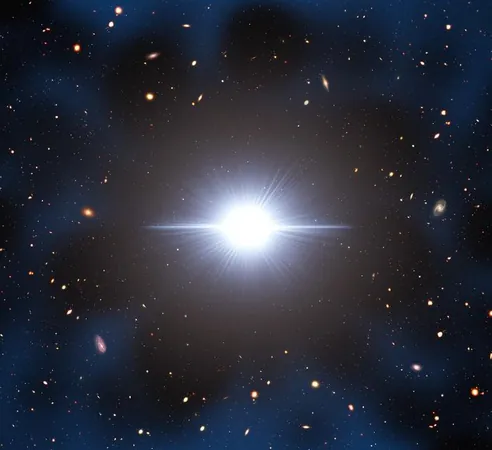
Unveiling the Mysteries of Early-Universe Quasars: New Revelations from DECam
2024-09-24
Unveiling the Mysteries of Early-Universe Quasars: New Revelations from DECam
Quasars, the brightest beacons in the cosmic landscape, represent the early universe's most energetic phenomena, fueled by enormous black holes devouring surrounding gas and dust. Recent research has turned the spotlight on early-universe quasars, revealing black holes of staggering mass that seem to have been consuming gas at alarming rates.
Astronomers generally believe these quasars arose in dense cosmic environments rich in gas, which would have readily fed the voracious black holes at their centers. However, efforts to verify this through observation have resulted in puzzlingly contradictory findings.
Now, a groundbreaking study utilizing the Dark Energy Camera (DECam) has shed light on these inconsistencies, providing a coherent theoretical framework that could unite disparate observational data. This research marks the most extensive sky search for early-universe quasars ever conducted.
A Revolutionary Approach to Quasar Research
Harnessing DECam’s unique three-square-degree field of view, a research team executed an unprecedented search around the quasar VIK J2348-3054, whose distance had already been determined through prior observations using the Atacama Large Millimeter/submillimeter Array (ALMA). This allowed the researchers to gauge the density of galaxies surrounding this particular quasar effectively.
The DECam's sophisticated technology includes a narrowband filter tailored to detect companion galaxies, enhancing the study's accuracy. "This quasar study really was the perfect storm," remarked Trystan Lambert, the study's lead author. "We had a quasar with a known distance, and DECam provided both the expansive view and the precise filter we needed."
Through this innovative approach, the team analyzed the unique Lyman-alpha radiation emitted by younger, smaller galaxies surrounding the quasar. This allowed them to identify and count 38 companion galaxies within a radius of 60 million light-years, aligning with theoretical expectations for quasars in densely populated areas.
Surprising Discoveries and Implications
However, a surprising twist in their findings emerged when they discovered that within a mere 15 million light-years of the quasar, no companion galaxies existed. This unexpected emptiness raises intriguing questions about quasar formation and the mechanisms that could lead to this scenario.
The implications of DECam's observations extend far beyond this single quasar. Previous attempts to classify early-universe quasars often occurred over smaller areas, which could distort the perceived density of their surrounding environments, potentially leading to the conflicting conclusions reported in earlier studies.
"DECam’s extremely wide view is necessary for thoroughly studying quasar neighborhoods. You need to explore a larger area to get the full picture," Lambert emphasized, highlighting the importance of this new methodology.
Looking to the Future
The team is currently engaged in follow-up observations to acquire spectral data that could further validate their findings surrounding star formation suppression. In addition to VIK J2348-3054, they plan to investigate other quasars, aiming to compile a more comprehensive dataset that could deepen our understanding of these enigmatic cosmic giants.
As researchers continue to unlock the secrets of the universe's earliest epochs, studies like these remind us of the untold stories still waiting to be discovered among the stars. Stay tuned for more revelations that could change our perspective on the cosmos and our place within it!

 Brasil (PT)
Brasil (PT)
 Canada (EN)
Canada (EN)
 Chile (ES)
Chile (ES)
 España (ES)
España (ES)
 France (FR)
France (FR)
 Hong Kong (EN)
Hong Kong (EN)
 Italia (IT)
Italia (IT)
 日本 (JA)
日本 (JA)
 Magyarország (HU)
Magyarország (HU)
 Norge (NO)
Norge (NO)
 Polska (PL)
Polska (PL)
 Schweiz (DE)
Schweiz (DE)
 Singapore (EN)
Singapore (EN)
 Sverige (SV)
Sverige (SV)
 Suomi (FI)
Suomi (FI)
 Türkiye (TR)
Türkiye (TR)